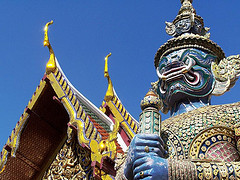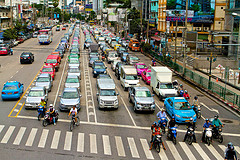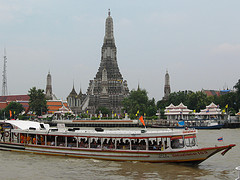History of Thailand
Built on a foundation of ancient kingdoms, dynasties, and warring city-states, Thailand has been undergoing a transformation into a modern nation striving for democratic rule since the early 1900s.
Thailand as we know it today did not exist as a nation until the early 1900s. Prior to the 1900s, various kingdoms vied for power across the land, creating a rich and fascinating historical saga. Thailand was referred to as the Kingdom of Siam up until 1939, when its name was officially changed to Thailand. The country went through another brief name change from 1945 to 1949, when its name was reverted to Siam and then back to Thailand on May 9, 1949.
Early History
The earliest history of Thailand includes Bronze Age and Iron Age sites discovered throughout the region, and even a few remains dating as far back as 1,000,000 years ago.
The first people to build significant civilizations in the area were the Khmer, Malay, and Mon. Their empires and kingdoms stretched across the region that encompasses Thailand, Laos, and Cambodia today. Strong elements of Indian culture characterized the religious beliefs, art, and architecture of these ancient city-states.
Around 700-1000AD, the Tai people began migrating south from China. The various Tai ethnic groups brought with them their own language, as well as their own belief systems and traditions. Initially, they stayed near mountains and river valleys, living in small villages among the indigenous Khmer, Malay, and Mon populations. However, within a few centuries, the vast central plains were inhabited primarily by people of Tai ethnicity.
In 1238, the powerful and dominant Khmer empire was overthrown by the Tai people. A new kingdom, called Sukhothai, was formed in central Thailand. Other groups of Tai people, reinforced by Tai warriors fleeing Kublai Khan’s conquests, overthrew the Mon empire in the north. They created a second Tai Kingdom called Lan Na.
For over a century, Sukhothai and Lan Na thrived. Sukhothai kings promoted Theraveda Buddhism, encouraged free trade, opened diplomatic and trade relations with China, and created the Thai script. However, Sukhothai soon fell to the emerging Ayutthaya Kingdom. During the period of Ayutthaya rule, from 1350 to 1767, Theraveda Buddhism was established as the primary religion, and the Dharmashastra legal code was compiled. This legal code drew on both Hindu sources and ethnic Tai customs to create a code that has strongly influenced the culture and laws of Thailand. Ayutthaya rulers also brought the Kingdom of Lan Na under their power, consolidating much of the area into a single Tai Kingdom with its own distinct religion and legal code.
The Ayutthaya Kingdom was weakened by infighting and eventually toppled by a Burmese invasion. Thus began a brief period of foreign rule. The capital city Ayutthaya, which had been one of the largest and most powerful trading centers in the world, was destroyed. However, the strength and solidarity among the Tai peoples of the region ran deep, and it was only a few decades before popular uprisings restored Tai rule under the Rattankosin Kingdom.
The Rattankosin Kingdom, ruled by the Chakri Dynasty, held power from 1782 to 1932. They are responsible for moving the capital to its present location, Bangkok. They were also the architects of numerous economic and technological modernizations that were critical in making the Land of Siam a modern nation.
The Rattankosin Kingdom existed at a time when European colonialism was rampant in South East Asia. Through careful negotiations and treaties, the Chakri kings skillfully navigated the world of global politics. Although they had to sacrifice some of their territory to the north and east, the Kingdom of Siam was the only South East Asian nation not to fall to European colonialism. A series of treaties with Britain and France in the early 1900s defined the borders with Malaysia in the south, and Cambodia and Laos in the North-East.
Although the name “Thailand” would not come into use for another 30 years, the nation as we know it today had been drawn out on the map.
Modern Thailand
After centuries of warring kingdoms and city-states, the Thai people desired a more stable and democratic government. The Chakri Dynasty had ruled the Kingdom of Siam since 1782. Beginning in the early 1900s, though, Thais began pushing for democratic reforms. Finally, in 1932, a successful coup created a constitutional monarchy and gave Thailand its first constitution.
This new government was destined to be short-lived. In-fighting and intrigues, as well as pressures from the outside world, led to a military take-over. An authoritarian regime under Luang Phibunsongkram soon dominated the land of Siam. Propaganda, and strict regulations on life, religion and art pushed indigenous cultures to the sidelines and set severe limits on creativity and freedom. Culture and performances were strictly controlled by the state, with the goal of creating a strong sense of national culture and identity. In 1939, the name of the country was officially changed to Thailand, to reflect the unity of the Thai people.
As the turmoil of World War II engulfed the world, Thailand engaged in a series of wars, invasions, alliances, and treaties. An uneasy alliance with Japan put Thailand officially on the side of the Axis powers, but Thai underground resistance movements aided the United States and the other Allied powers. By 1945, Thailand stood in close alliance to the United States, and had gained membership into the United Nations.
Various military dictators ruled Thailand until 1976. During the 1980s and 1990s, Thai politics was characterized by attempts at democratic reforms.
The 1980s saw a relatively stable democratic rule under Prime Minister Prem Tinsulanonda. This decade also saw important economic growth and development. Manufacturing and tourism took off, and became even more economically important than the export of rice. However, military coups and popular uprisings during the 1990s made the road to Democratic rule a rocky one.
The 21st Century has seen Thailand’s government, economy, and infrastructure undergo numerous changes and modernizations. The Thai Rak Thai Party (TRT), under the hugely influential Prime Minister Thaksin Shinawatra, was elected to power in 2001. Thaksin instituted universal health care, provided funds for village development, and significantly reduced drug usage throughout Thailand. However, accusations of corruption and violence led to the removal of the TRT from power in 2006, and the imprisonment of their leader, Thaksin.
Thailand’s Current Politics
Anyone who has followed the news has no doubt heard about Thailand’s political unrest during the past few years. Although there have been many different players, political parties, and activist groups involved in these complex events, things can be broken down to two main groups:
The first group encompasses the supporters of former Prime Minister Thaksin. This group has, at various times, been known as “Red Shirts,” the TRT, PPP, and UDD. The current incarnation of Thaksin’s supporters and political party is the PTP (Pheu Thai Party), which, as of 2011, is the ruling party in Thailand.
The second group is comprised of the PAD party, royalist supporters, and primarily middle and upper-class Thais, with Prime Minister Abhisit at its forefront.
The PAD party had played an important role in removing the Thaksin and his TRT party from power in 2006. However, despite the fact that Thaksin was forced to leave the country and could no longer play a direct role in Thai politics, his supporters formed a new political party, the PPP. This party came into power after the TRT party was outlawed.
In 2008, PAD came back into power to protest and take action against the current pro-Thaksin government. They shut down Bangkok’s transportation system with strikes, and occupied government grounds. Escalating tensions eventually erupted into violence, a clash between protesters and the army, and a state of emergency in Bangkok.
Finally, a new prime minister, Abhisit Vejjajiva, came into power, with the support of the PAD party. He was one of the most severe censors in Thailand’s history, and was frequently accused of ruling only for the noble elite while ignoring the needs of the poor and less privileged. Soon, violent protests, riots, and attempted assassinations engulfed Thai politics. These protests were led by a group called the UDD. This political activist group supported Thaksin and were also often referred to as the Red Shirts.
In 2010, after refusing to honor the Red Shirts’ calls for a fair general election, Abhsit’s government began a crackdown. Red Shirts were, often violently, forced to surrender or driven out of Bangkok.
It wasn’t until the general elections on July 3, 2011, that Thaksin’s supporters came back to power. The Red Shirts’ demands for general elections had finally been met, and the Pro-Thaksin PTP party won in a landslide victory. Thaksin’s sister, Yingluck Shinawatra, was elected party leader and Prime Minister of Thailand. The fact that Abhisit and his party accepted the results of the election and stepped down peacefully from power shows how far the state of democracy has come in Thailand.





